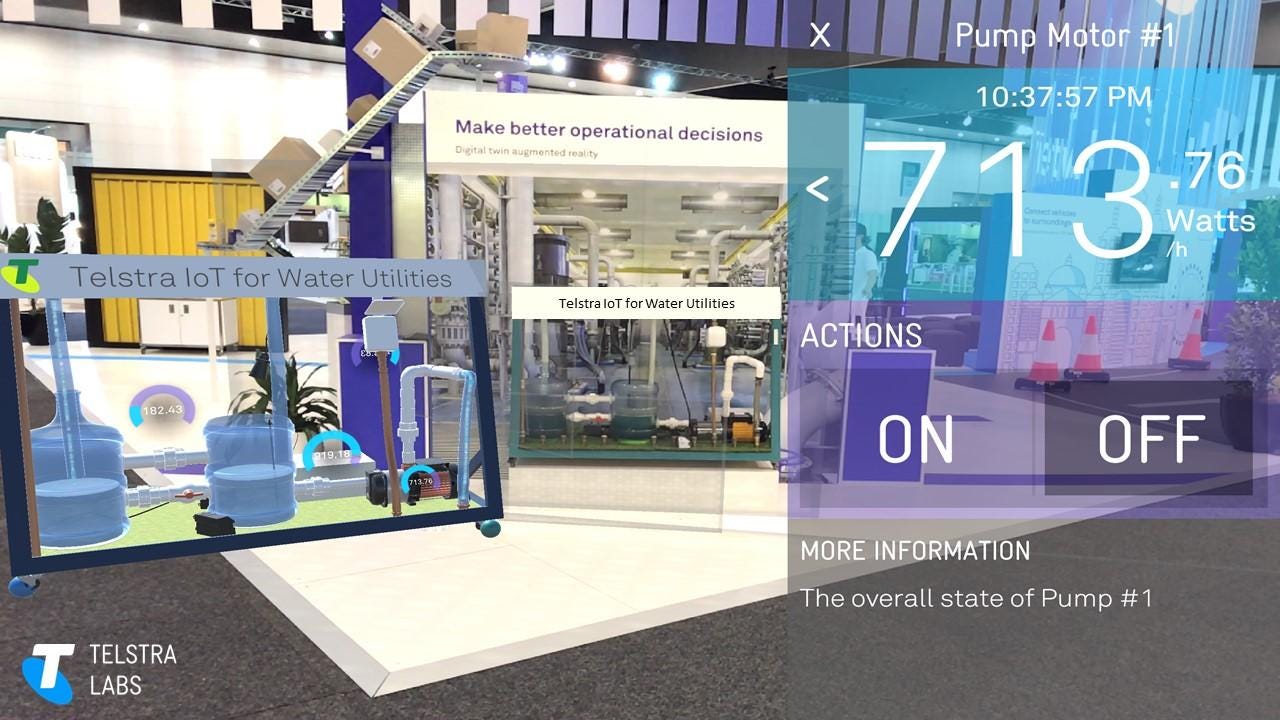Telstra mixes up physical and digital realities for better water flow


Telstra is in the early stages of developing proof-of-concept digital twins with potential uses cases in several industries, including farming, manufacturing, logistics, traffic flows for city councils, and for environmental organisations.
It comes off the back of work done on an initial proof-of-concept that was showcased recently at Telstra Vantage. The Australian telco provider developed a digital twin of a water system to demonstrate that by developing an exact digital replica of a physical asset, users could view that digital replica through a dashboard on a tablet or virtual reality (VR) goggles and digitally simulate potential scenarios to make informed and proactive decisions.
"We wanted to try out the technology," Telstra CTO Hakan Eriksson told ZDNet.
"It was just a water pump and a few water containers to basically show you what the flow of water was and how quickly the tank could overflow if you made a certain decision. You can do it in the digital world instead of the real world, so you don't have to mop up the floors. You can carry out the experiment using the digital twin.
"It was more of a showcase to demonstrate what it can be used for."
SEE: Executive's guide to the business value of VR and AR (free ebook)
According to Eriksson, there are three main advantages of creating digital twins, which is made possible through 4G and 5G connectivity and Internet of Things (IoT) sensors that gather real-time data from the physical world to simulate scenarios in the cloud based on the data.
"The advantage of having a use case of a digital twin is one: you can have all the measurements, or what the temperature is of something in one place, and it becomes an advanced dashboard," he said.
"Number two is that it becomes an advanced remote control where you increase or decrease the speed of something, instead of going out to the device itself.
"The third thing is that it becomes a simulator -- and this where it gets more interesting – because in the digital world if you have the right models and the right data, you can fast forward what's going to happen to this, if I do this. On top of that, once you have that simulator, then it can become a training environment."
See also: Can you use AR and VR to teach employees soft skills? (TechRepublic)
Eriksson also pointed to how fire departments could potentially use digital twins to create training environments for emergencies, as another application example.
"You could have a digital twin of a complete factory to know if there was a fire, as the head of a fire department, [and consider] if I can send my fire brigade guys into this place. Is it safe? or what would it be like in there in half an hour from now? what will they see when they get in there?" he said.
"You could eventually put on VR glasses, fast forward half an hour, and see what it's going to be like. Where can I move and where can I not move."
Surgery made easier
AR + VR
A VR prototype is also currently being developed by Vantari VR for the Ear Nose Throat (ENT) Department at Sydney's Royal Prince Alfred Hospital.
The solution is being designed to help improve the way ENT surgeons currently perform surgery, which involves examining CT scans prior to surgery before operating through the sinus and into the brain.
"At the moment, what we rely on primarily is X-ray and CT scans. But what these give us is a two-dimensional picture, but we're operating in a three-dimensional space," said head of ENT Department at the Royal Prince Alfred Hospital Arjuna Ananda.
"You might think imaging is very advanced, but it hasn't really changed in 30 years. What we're doing is basically evaluating the human body in two-dimensional, black and white series' of slices.
"This I believe is a bit of a problem. For me, even before the patient arrives in the operating theatre, I need to evaluate these scans. Currently, for me to evaluate these scans and translate what I see in my head [is a difficult process] and every surgeon faces that issue.
"Now an experienced surgeon is very good at doing that. But even though I've been doing it for 20 years, I still have trouble translating 2D images into a 3D model."
Ananda said the risk of not interpreting the CT scans correctly can result in "catastrophic consequences".
"Someone could go blind or rupture an artery," he said.
Having scans accessible through VR however, can provide visual and spatial recognition of the necessary structures that surgeons require, Ananda said. "It's an adjunct to the CT scan."
At the same time, Ananda believes VR can make ENT surgery more accessible to younger surgeons and medical students.
"Instead of going to an anatomy lab, picking through a dead body or a mannequin that lacks realism, I can put the cadaver in front of you, peeling the skin off, looking at each nerve -- I think that is a big application. It will replace text books and it can be applied to medical students in training," he said.
Related Coverage
- Microsoft's latest holoportation demo shows off its mixed reality, AI, translation technologies
- Qualcomm XR enterprise program blends vendor matchmaking and mixed reality
- Ready for takeoff: Airbus's sweeping mixed reality redesign
- CSIRO's Data61 opens Mixed Reality Lab in Melbourne
- Telepresence robots for all budgets: Robotics firm improves devices with mixed reality
- Teleport to work: Double ditches the iPad, adds mixed reality
- CSIRO's Data61 opens Mixed Reality Lab in Melbourne